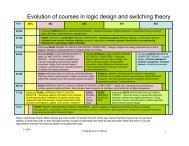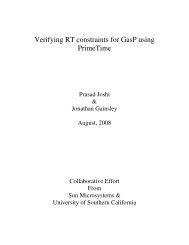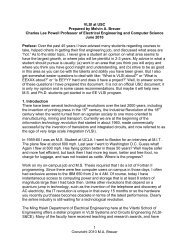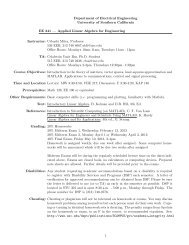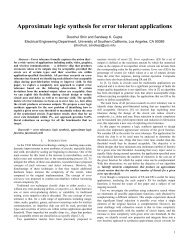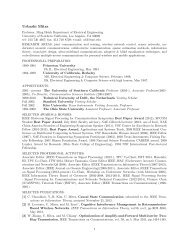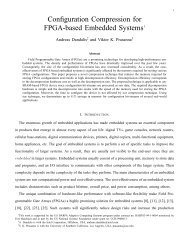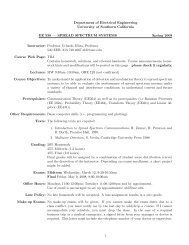A Carbon Nanotube Spiking Cortical Neuron with Tunable ...
A Carbon Nanotube Spiking Cortical Neuron with Tunable ...
A Carbon Nanotube Spiking Cortical Neuron with Tunable ...
Create successful ePaper yourself
Turn your PDF publications into a flip-book with our unique Google optimized e-Paper software.
A <strong>Carbon</strong> <strong>Nanotube</strong> <strong>Spiking</strong> <strong>Cortical</strong> <strong>Neuron</strong> <strong>with</strong><br />
<strong>Tunable</strong> Refractory Period and <strong>Spiking</strong> Duration<br />
Abstract—This paper describes an analog tunable carbon<br />
nanotube axon hillock that exhibits spiking <strong>with</strong> control over<br />
spiking frequency and spiking duration. Experiments <strong>with</strong> the<br />
axon hillock circuit embedded in a neuron circuit demonstrate<br />
spiking patterns similar to a biological fast-spiking neuron. The<br />
circuit design is biomimetic and changes in control voltages lead<br />
to changes in key spike parameters such as spike refractory period<br />
and spiking duration. The effect of change in output spiking<br />
frequency is tested <strong>with</strong> synapses that temporally summate, and<br />
their effect on neural firing is observed. The experiments are<br />
demonstrated <strong>with</strong> SPICE simulations using carbon nanotube<br />
transistor simulation models.<br />
I. INTRODUCTION<br />
Most biological neurons fire by emitting several closelyspaced<br />
spikes or a burst of spikes when input stimulation is<br />
sufficient to cause spiking. The biological mechanism behind a<br />
neural spike is well understood [1]. Bursts of spikes or higherfrequency<br />
spike trains are more likely to result in relaying<br />
sensory inputs to the cortex than lower-frequency trains [2].<br />
<strong>Neuron</strong>s in the visual cortex respond <strong>with</strong> varying frequency<br />
when there is a detection of an edge at a particular orientation<br />
[3], depending on the contrast of the edge.<br />
<strong>Spiking</strong> neurons can be classified into many types [4]. A<br />
recent publication [5] describes neurons in the somatosensory<br />
cortex that are classified as either Regular <strong>Spiking</strong> (RS)<br />
pyramidal or Fast <strong>Spiking</strong> (FS) interneurons. RS neurons have<br />
a higher spiking rate from the onset of spiking and settle down<br />
to a base frequency whereas FS cells have a high frequency<br />
from onset itself, and cease spiking completely when the cell<br />
membrane potential drops below a critical threshold.<br />
This paper describes a carbon nanotube circuit design of<br />
a tunable spiking axon hillock, as a part of a typical cortical<br />
neuron that behaves much like a biological fast-spiking<br />
neuron. The circuit design is biomimetic and sections of<br />
the circuit can be directly linked to fundamental biological<br />
spiking mechanisms. The novel design has voltage controls in<br />
different sections of the circuit that tune the design, changing<br />
key spiking parameters such as refractory period (spiking<br />
frequency) and the total duration of spiking. We demonstrate<br />
Support for this research has been provided by the Viterbi School of<br />
Engineering and the WiSE program at the University of Southern California,<br />
and this material is based upon work supported by the National Science<br />
Foundation under Grant No. 0726815. Any opinions, findings, and conclusions<br />
or recommendations expressed in this material are those of the author(s) and<br />
do not necessarily reflect the views of the National Science Foundation.<br />
Jonathan Joshi, Alice C. Parker, and Chih-Chieh Hsu<br />
Ming Hsieh Department of Electrical Engineering<br />
University of Southern California<br />
the effect of change in frequency by impinging the output<br />
action potentials of the neuron onto a similar neuron <strong>with</strong><br />
synapses that temporally summate. The simulation results<br />
demonstrate that a higher spiking frequency is necessary to<br />
raise the dendritic potential in the post-synaptic neuron enough<br />
so that the second neuron fires. This design is believed to be<br />
novel <strong>with</strong> respect to its embedded feedback controls over total<br />
spiking duration, and its completely analog implementation, as<br />
well as the circuit implementation using carbon nanotube transistor<br />
models. Another version of the circuit to be reported on<br />
later exhibits tonic spiking and membrane voltage-dependent<br />
spiking frequency, behaving much as its biological regularspiking<br />
neural counterpart.<br />
II. BACKGROUND<br />
Liu and Frenzel’s spike train neuron is sn early mixed-signal<br />
electronic neural model [6]. Hynna and Boahen [7] describe<br />
a silicon thalamic relay neuron that exhibits tonic firing, then<br />
bursts <strong>with</strong> sufficient simulation. This neuron uses a spiking<br />
circuit [8] that depends on an off-chip reset signal from a<br />
digital circuit to regenerate a spike. Farquhar and Hasler [9]<br />
describe a biomimetic axon hillock circuit, and demonstrate<br />
changes in spiking frequency when different amplitudes of<br />
current are injected into the circuit. An electronic neuron<br />
design <strong>with</strong> both inhibition and excitation models a bursting<br />
oscillator <strong>with</strong> a depressed synapse constructed of a current<br />
mirror and amplifier, <strong>with</strong> the circuit modulating the output<br />
current of the synapse [10] <strong>with</strong>out control over frequency<br />
or spiking duration. These oscillators are found in central<br />
pattern generators in neural circuits. Work done by Indiveri<br />
[11] presents a firing circuit similar to our axon hillock circuit<br />
in terms of the refractory period control but lacks control over<br />
variations in total spiking duration.<br />
<strong>Carbon</strong> nanotubes (CNTs) can behave as metallic wires as<br />
well as FETs. CNTs are a few nm in diameter. Current flow<br />
is largely ballistic (comparable to the flow of electrons in free<br />
space), capacitances are in attofarads, and rise and fall times<br />
in picoseconds. Channel resistance is primarily due to the<br />
quantum resistance at the junction between the nanotubes and<br />
metallic connections. Current flow between drain and source<br />
is less easily controlled than <strong>with</strong> CMOS circuits. Appropriate<br />
interfaces could be used to convert to/from biological signal<br />
levels and delays. <strong>Nanotube</strong>s induce minimum immune system<br />
reactions in living tissue [12].
Single-walled carbon nanotubes avoid most of the scaling<br />
limits of silicon [13]. Paul et al. [14] demonstrated that carbon<br />
nanotube field-effect transistors (CNFETs) are less sensitive<br />
to the geometry-related process variations than silicon MOS-<br />
FETs. <strong>Carbon</strong> nanotubes have the potential to be configured<br />
into 3-D arrangements, a capability we believe will become<br />
critical when implementing larger portions of the cortex due<br />
to the massive connectivity. <strong>Carbon</strong> nanotube circuits have<br />
the potential to be reconfigured in real time, a capability we<br />
feel is essential for learning. A technique has been proposed<br />
recently to design CNT circuits immune to misalignment and<br />
mispositioning that can guarantee the correct function being<br />
implemented [15]. Liu, Han and Zhou have demonstrated<br />
directional growth of high-density carbon nanotubes on a- and<br />
r-plane sapphire substrates [16]. They have developed a novel<br />
nanotube-on-insulator (NOI) approach, and a way to transfer<br />
these nanotube arrays to flexible substrates.<br />
A CNFET device model <strong>with</strong> circuit-compatible structure<br />
including typical device non-idealities is used in our simulations.<br />
[17]. The strength of our model and similar models is<br />
the correspondence between individual circuit elements and<br />
specific physiological mechanisms in the biological neuron<br />
that allow us to vary axon hillock behavior easily <strong>with</strong> control<br />
inputs. This, and our choice of carbon nanotube technology,<br />
differentiates this work. However, we are investigating alternatives;<br />
a CMOS chip <strong>with</strong> basic neural circuits is being<br />
fabricated, and other nanotechnologies are under investigation.<br />
III. THE CARBON NANOTUBE NEURON CIRCUIT<br />
Our basic cortical neuron [18] consists of four types of submodules:<br />
the basic excitatory synapses ( [19]), the simplified<br />
dendritic arbor [20] and the axon hillock. Circuit models<br />
for the dendrites are not provided here. We have used four<br />
synapses [20] and tuned the threshold of the axon hillock so<br />
that it spikes when all four synapses exhibit a typical EPSP.<br />
The synapse implemented in the neuron is a biomimetic<br />
depolarizing excitatory synapse circuit, <strong>with</strong> correspondence<br />
between biological mechanisms and circuit structures. This circuit<br />
models cell potentials and neurotransmitter concentrations<br />
<strong>with</strong> voltages, <strong>with</strong> a correspondence between circuit elements<br />
and biological mechanisms.<br />
The adder circuit in the simplified dendritic arbor [21] has<br />
been shown previously [20]. The dendritic arbor portion used<br />
for testing was published earlier [20].<br />
There are four excitatory synapses in the arbor, each on<br />
a separate dendritic branch. Previous work [19] has shown<br />
that the synapses used in our neuron have the capability of<br />
temporal summation.<br />
A. Biomimetic Axon Hillock Circuit<br />
In a biological neuron, the axon hillock has the highest<br />
density of sodium channels, resulting in the lowest threshold<br />
(-55 mV) compared to elsewhere in the neuron to initiate<br />
an action potential. As shown in Figure 1, if the summation<br />
of post-synaptic potentials (PSPs) connected to the gate of<br />
transistor X2 reaches a threshold value, the Gated Ion Channel<br />
section raises its potential at point A indicating the opening<br />
of a voltage-gated ion channel. The raised potential at A is<br />
inverted to turn on PMOS X7 and the axon hillock circuit<br />
will initiate spiking. To mimic a fast-rising phase (due to<br />
the rapid increase of the sodium channel conductance) and<br />
a slower falling phase (due to the slower increase of the<br />
potassium channel conductances) of an action potential, we<br />
adjusted the pull-up and pull-down strengths of transistors<br />
X7, X8 and X9. Inverters 1 and 2 in the Potassium Delay<br />
were tuned to model the time courses (time constants) in the<br />
dynamic mechanisms of the voltage gated ion channels. The<br />
Sodium Ion Delay Section controls the delay for which the<br />
sodium channel conductance remains deactivated by turning<br />
off transistor X8. The voltage across the gate of transistor<br />
X15 (refractory period control) controls the spiking refractory<br />
period and hence spiking frequency. The voltage across the<br />
gate of transistor X4 (<strong>Spiking</strong> Duration Control) in the Gated<br />
Ion Channel Section controls how fast the voltage at point A<br />
will decay and hence controls the overall duration of spiking.<br />
In a typical biological neuron, potentials range from around<br />
-75 mV to +40 mV <strong>with</strong> action potentials peaking around<br />
+40 mV. Since the carbon nanotube neuron is designed to<br />
operate <strong>with</strong> Vdd around 0.9 V as the peak action potential<br />
voltage, and <strong>with</strong> 0.0 V (Ground) as the resting potential,<br />
the post-synaptic potentials were scaled accordingly, <strong>with</strong><br />
0.0 V circuit potential corresponding to -75 mV biological<br />
potential and 0.9 V circuit potential corresponding to 40<br />
mV biological potential. We scaled the delays <strong>with</strong> about 1<br />
ms in the biological neuron scaling to about 10 ps in the<br />
nanotube neuron [22]. The postsynaptic potential appearing<br />
at the dendritic trunk is approximately 14% of the action<br />
potential and the duration is about 6 times as long as the<br />
action potential, similar to biological EPSPs described in the<br />
literature.<br />
IV. EXPERIMENTS WITH THE CORTICAL NEURON<br />
The neuron was tested <strong>with</strong> action potentials input to each<br />
synapse, and the output of the neuron measured. As shown<br />
in Figure2 the input APs 1 and 2 (green trace, superimposed)<br />
cause the dendritic potential (red trace) to rise and cause the<br />
axon hillock to produce spikes (purple and blue traces). As we<br />
observe in Figure 2, by varying the <strong>Spiking</strong> Duration Control<br />
voltage, the spiking duration in the upper trace (purple trace)<br />
can be adjusted longer than the spiking duration in the lower<br />
trace (blue trace). Figure 5 shows the variation in the spiking<br />
duration <strong>with</strong> change in <strong>Spiking</strong> Duration Control voltage.<br />
We tuned the axon hillock to different refractory periods and<br />
hence different firing frequencies by varying the control voltage<br />
Refractory Period Control. The action potentials generated<br />
by the test neuron (<strong>Neuron</strong> 1) were fed to the synapses of a<br />
similar second neuron (<strong>Neuron</strong> 2) and the output of <strong>Neuron</strong><br />
2 was observed. In Figure 3, when the output refractory<br />
period is adjusted to 30 ps (refractory period control=0.3 V)<br />
(red trace) then there is temporal summation on the synapses<br />
(purple trace) of <strong>Neuron</strong> 2 to further cause the dendritic<br />
voltage of <strong>Neuron</strong> 2 to temporally sum (blue trace). This
causes neuron 2 to produce an output train of action potentials<br />
(orange). On the other hand, as shown in Figure 4, when the<br />
output refractory period is adjusted to 50 ps (refractory period<br />
control=0.6 V) (red trace) there is no temporal summation<br />
on the synapses (purple trace) of <strong>Neuron</strong> 2 hence there is<br />
no temporal summation of the dendritic voltage (blue trace)<br />
which in turn fails to excite neuron 2 to produce a train of<br />
action potentials (orange trace at .048 mV ).<br />
V. CONCLUSION<br />
A carbon nanotube cortical neuron <strong>with</strong> a tunable spiking<br />
axon hillock is presented here, and simulations testing the<br />
tunability are shown. Simulations have demonstrated changes<br />
in spiking frequency and spiking duration as control voltages<br />
are changed, resulting in biomimetic behavioral variations in<br />
spiking and post-synaptic neural stimulation.<br />
REFERENCES<br />
[1] E. Kandel, J. Schwartz, and T. Jessel, Principles of Neural Science,<br />
vol. 4. McGraw-Hill, 2004.<br />
[2] M. Beierlein, C. P. Fall, J. Rinzel, and R. Yuste, “Thalamocortical bursts<br />
trigger recurrent activity in neocortical networks: Layer 4 as a frequencydependent<br />
gate,” J. Neurosci., vol. 22, pp. 9885–9894, November 2002.<br />
[3] R. von der Heydt, H. Zhou, and H. S. Friedman, “Representation of<br />
stereoscopic edges in monkey visual cortex,” Vision Research, vol. 40,<br />
pp. 1955–1967, July 2000.<br />
[4] E. M. Izhikevich, “Simple model of spiking neurons,” Neural Networks,<br />
IEEE Transactions on, vol. 14, no. 6, pp. 1569–1572, 2003.<br />
[5] T. Tateno, A. Harsch, and H. P. C. Robinson, “Threshold firing<br />
frequency-current relationships of neurons in rat somatosensory cortex:<br />
Type 1 and type 2 dynamics,” J Neurophysiol, vol. 92, pp. 2283–2294,<br />
October 2004.<br />
[6] B. Liu and J. F. Frenzel, “A CMOS neuron for VLSI circuit implementation<br />
of pulsed neural networks,” in Industrial Electronics Society, IEEE<br />
2002 28th Annual Conference of the, vol. 4, pp. 3182–3185 vol.4, 2002.<br />
[7] K. M. Hynna and K. Boahen, “Silicon neurons that burst when primed,”<br />
in Circuits and Systems, 2007. IEEE International Symposium on,<br />
pp. 3363–3366, 2007.<br />
[8] K. A. Zaghloul and K. Boahen, “Optic nerve signals in a neuromorphic<br />
chip ii: testing and results,” Biomedical Engineering, IEEE Transactions<br />
on, vol. 51, no. 4, pp. 667–675, 2004.<br />
Fig. 1. The Axon Hillock Circuit<br />
Fig. 2. Input action potential (green trace) and resultant increase in dendritic<br />
potential (red trace) leading to continuous neural spiking of higher duration<br />
(purple trace) and lower duration (blue trace)<br />
[9] E. Farquhar and P. Hasler, “A bio-physically inspired silicon neuron,”<br />
Circuits and Systems I: Regular Papers, IEEE Transactions on, vol. 52,<br />
no. 3, pp. 477–488, 2005.<br />
[10] K. Nakada, T. Asai, and Y. Amemiya, “Analog CMOS implementation<br />
of a bursting oscillator <strong>with</strong> depressing synapse,” in Intelligent Sensors,<br />
Sensor Networks and Information Processing Conference, 2004. Proceedings<br />
of the 2004, pp. 503–506, 2004.<br />
[11] G. Indiveri, “A low-power adaptive integrate-and-fire neuron circuit,”
Fig. 3. High frequency firing in neuron 1 leads to an output spike train from<br />
neuron 2<br />
in Circuits and Systems, 2003. Proceedings of the 2003 International<br />
Symposium on, vol. 4, pp. IV–820–IV–823 vol.4, 2003.<br />
[12] A. Bianco, R. Sainz, S. Li, H. Dumortier, L. Lacerda, K. Kostarelos,<br />
S. Giordani, and M. Prato, Biomedical Applications of Functionalised<br />
<strong>Carbon</strong> <strong>Nanotube</strong>s, pp. 23–50. 2008.<br />
[13] A. C. Parker, A. Friesz, and K. Pakdaman, “Towards a nanoscale<br />
artificial cortex,” in Proceedings of The 2006 International Conference<br />
on Computing in Nanotechnology (CNAN’06), June 2006.<br />
[14] B. C. Paul, S. Fujita, M. Okajima, T. H. Lee, H. S. P. Wong, and<br />
Y. Nishi, “Impact of a process variation on nanowire and nanotube device<br />
performance,” Electron Devices, IEEE Transactions on, vol. 54, no. 9,<br />
pp. 2369–2376, 2007.<br />
[15] N. Patil, J. Deng, A. Lin, H. S. P. Wong, and S. Mitra, “Design<br />
methods for misaligned and mispositioned carbon-nanotube immune<br />
circuits,” Computer-Aided Design of Integrated Circuits and Systems,<br />
IEEE Transactions on, vol. 27, no. 10, pp. 1725–1736, 2008.<br />
[16] X. Liu, S. Han, and C. Zhou, “Novel nanotube-on-insulator (noi)<br />
approach toward single-walled carbon nanotube devices,” Nano Letters,<br />
vol. 6, pp. 34–39, January 2006.<br />
[17] J. Deng and H. S. P. Wong, “A circuit-compatible spice model for enhancement<br />
mode carbon nanotube field effect transistors,” in Simulation<br />
of Semiconductor Processes and Devices, 2006 International Conference<br />
on, pp. 166–169, 2006.<br />
[18] J. Joshi, C. Hsu, A. Parker, and P. Deshmukh, “A carbon nanotube<br />
cortical neuron <strong>with</strong> excitatory and inhibitory dendritic computations,”<br />
in IEEE/NIH 2009 LIfe Science Systems and Applications Workshop,<br />
2009.<br />
[19] A. K. Friesz and A. C. Parker, “A biomimetic carbon nanotube synapse,”<br />
Fig. 4. Low frequency firing from <strong>Neuron</strong> 1 fails to produce an output from<br />
neuron 2<br />
Fig. 5. Change in spike duration window <strong>with</strong> change in Duration Control<br />
Voltage<br />
in Biomedical Engineering Conference, 2007.<br />
[20] A. C. Parker, J. Joshi, C.-C. Hsu, and N. A. D. Singh, “A carbon nanotube<br />
implementation of temporal and spatial dendritic computations,”<br />
in Circuits and Systems, 2008. MWSCAS 2008. 51st Midwest Symposium<br />
on, pp. 818–821, 2008.<br />
[21] H. Chaoui, “CMOS analogue adder,” Electronics Letters, vol. 31, no. 3,<br />
pp. 180–181, 1995.<br />
[22] C. Yu-Ming, L. Rosene, J. Killiany, A. Mangiamele, and I. Luebke,<br />
“Increased action potential firing rates of layer 2/3 pyramidal cells in<br />
the prefrontal cortex are significantly related to cognitive performance<br />
in aged monkeys,” Cerebral Cortex, vol. 15, pp. 409–418, April 2005.




